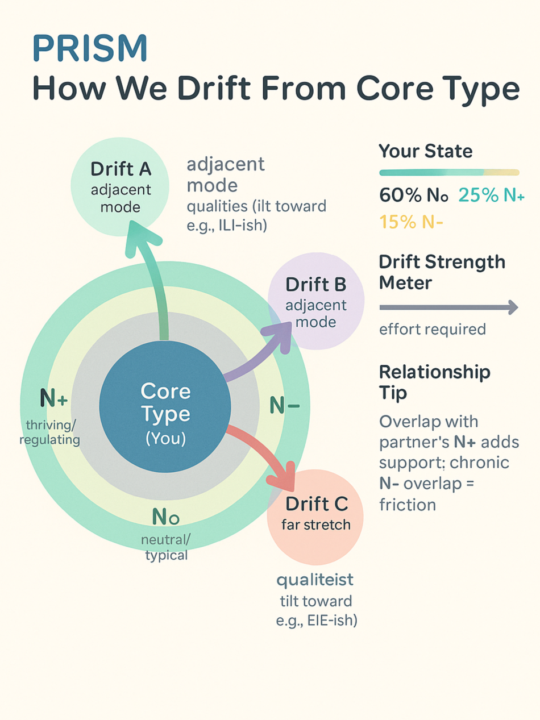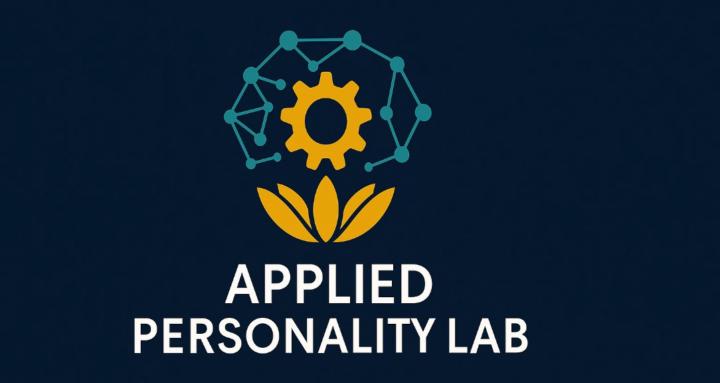
Write something
PRISM for Teams — Easy Mode (save this)
Most teams don’t have a people problem—they have a placement problem. Use PRISM to put people where they shine, add a counter-balance, and adjust when calm vs. under pressure. 1) Staff to strengths Pro (4D): designs the system, sets standards, teaches. Strong (3D): tackles complex work, mentors peers. Steady (2D): runs the routine play with SOPs & checklists. Careful (1D): lighter scope, clear templates, peer review. 2) Buddy checks (to catch blind spots) Data ↔ Values: KPIs meet “should we?” Logic ↔ People: rules meet message & impact. Vision ↔ Reality: long-range plan meets field test. Ideas ↔ Routines: brainstorm meets QA & adoption. 3) When calm vs. under pressure Calm (N+): pre-commit checklist, small batches, tight feedback loops. Pressure (N−): widen options, rotate ownership, add an external review. Try it this week (10-minute setup) List your top 5 team tasks. Mark each person’s level per task: Pro / Strong / Steady / Careful. Assign the owner by strongest level. Add a counter-buddy.
2
0
New Video: PRISM in 10 Minutes (Dynamic types, real-life application)
We’ve got a concise intro to PRISM live today. It covers why types aren’t cages, how Strength (expression) and Dimensionality (depth) work together, and how State (calm/stress/flow) changes performance without changing your core type. Watch: https://youtu.be/3OtBdlkN7WE This week’s Lab Prompt (comment your answers): State Check: What state did you catch yourself in today—calm, stress, or flow? One sentence on how you knew. Function Pair: Pick one overused and one underused function. Label each with Strength (low/med/high) + Dimension (1D–4D). One Rep: What single, 10-minute action will you take to train the underused function? Reply using this template: Type (if known): Current state (calm/stress/flow): Overused function — Strength/Dimension: Underused function — Strength/Dimension: My 10-minute rep this week: One metric I’ll track (what will improve?): Office-Hours Thread: Drop questions on mapping state vs type, and I’ll reply with targeted drills or pairing suggestions.
1
0
Behavior snapshots ≠ decision systems: why most “brain→behavior” profiles stall at now what? (and what my PRISM fixes)
A lot of popular profiles map observable behavior (sometimes with neuro-flavored marketing), but don’t model a person’s core identity or valued preferences—so they can’t reliably tell you what to do next. I’m building PRISM: a Socionics-rooted, trait-plus-state model with a stable identity layer and a small set of state modes that explain when/why you “look like” other styles. The goal is decision support, not just descriptions. Would love critical feedback on the psychometrics. The critique (aimed at behavior-snapshot systems) 1. No latent identity. They treat today’s expression as the ground truth. That’s volatile and context-dependent. 2. No value function. Without modeling what the person cares about, you can’t rank choices; advice stays generic. 3. No state mechanics. Stress/time pressure/social demand change expression, but most tools don’t model the how/why—they just describe it after the fact. 4. Result: great language, weak decision utility. You get “you’re high in X today,” but not a policy for what to do in this situation. ⸻ What PRISM does differently (system design, not hype) • Identity (stable): 8 continuous function traits (Te, Ti, Fe, Fi, Se, Si, Ne, Ni) + valued preferences (which pairs you elevate under choice/pressure). • State (situational): 3–4 compact modes (e.g., arousal × orientation) that apply gain patterns to the identity vector—predicting how expression shifts. • Lookalikes (derived, not reassigned): In certain modes, your expression may sit closer to another type centroid (e.g., an LIE presenting ILI-ish in a low-arousal, abstract mode). That’s shown as proximity, never as a new identity. Decision grammar (what users actually get): \pi(I, V, M, X) \rightarrow \text{policy} Where I = identity (traits), V = valued preferences, M = current mode, X = context (stakes, audience, time horizon). Output = ordered moves, guardrails, and a 2–3 step reset for that situation. Example: • Mode: high-arousal × relational → boost Fe/Ne; Do: socialize the “why”, offer two options, close fast. Don’t: Ti rabbit holes. Reset: brief Si grounding (timebox + environment tweak).

Prism is on track to do great things. Where we are across the board (Sneak peeks)
Here is what I am looking to accomplish (somehow by myself) - Unify data and establish SSOT (single source of truth) for all data, scoring and assessment methodologies. - Reestablish findings with all complete data being consistent. - Recompute user results to version 1 of testing frameworks. - Analyze same-type // cross type variance/invariance for all components. - Rigorously find inconsistencies and anomalies in framework - Get website to produce a high quality basic iteration of user results. - Basic user portal to review historical assessment results, time locked for retest. - 500 Assessment Milestone - Incorporate all traits in scoring, relational fit, ect. - TBD
1
0
1-30 of 52

skool.com/psychology-enthusiasts-9404
Turn self-knowledge into clearer performance and conversations in 7 days or less.
Powered by



